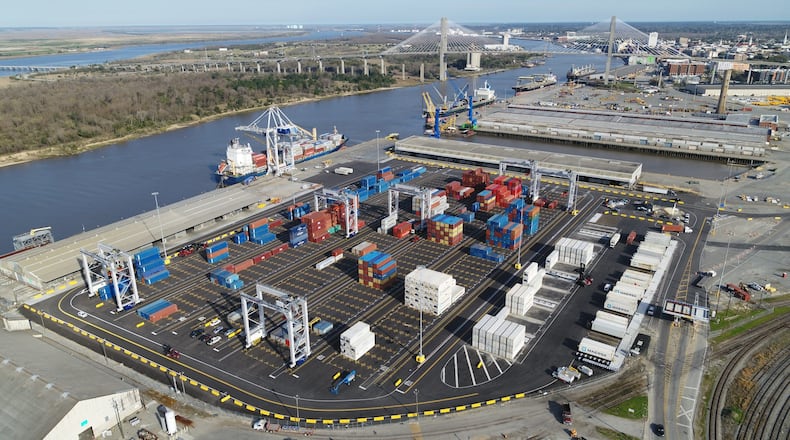The Georgia Ports Authority board on Monday approved a plan to renovate docks at its Ocean Terminal in Savannah to handle more container traffic, creating flexibility to grow over the next eight to 10 years.
The complicated project will allow the Savannah port to accommodate at once two additional large freighters at the Ocean Terminal, boosting dockside and yard capacity to relieve congestion at the nearby Garden City Terminal. The 200-acre Ocean Terminal overhaul also reflects the continued boom in containerized freight that the port has seen since expansion of the Panama Canal in 2016 and the recent deepening of the Savannah River.
The Ocean Terminal is best known for “breakbulk” cargo, or freight such as heavy machinery and certain automotive products that do not fit into standard container boxes. As part of Monday’s vote, the Georgia Ports said breakbulk cargo handled by shipping giant Wallenius Wilhelmsen Ocean will move from Savannah to Colonel’s Island Terminal in Brunswick, where construction has started on new dockside warehousing and an expansion of auto storage space is underway.
Savannah is one of the nation’s fastest-growing and busiest seaports and has seen a surge in container shipping since the expansion of the Panama Canal. Earlier this year, the Army Corps of Engineers completed a deepening of the Savannah River channel to 47 feet, a decades-long effort to allow larger ships to pass.
“I think what’s really exciting is we’re going from a Southeast gateway to a global gateway,” Georgia Ports Executive Director Griff Lynch said in an interview with The Atlanta Journal-Constitution.
Georgia’s inland and coastal ports are vital cogs in the state’s economy, and key indicators of global economic health. The volume of cargo flowing through Savannah and Brunswick signals consumer demand for imports and the appetite abroad for Georgia grown or manufactured products.
A recent study by the University of Georgia found maritime trade accounts for $44 billion of the state’s gross domestic product, with the ports directly or indirectly touching more than 439,000 jobs.
The authority said Monday it handled 1.5 million TEUs or 20-foot equivalent container units, in the quarter that ended in September, an increase of nearly 10% over the same period last year.
Global supply chains were affected by COVID-19 and many U.S. ports saw backlogs of ships waiting to dock as consumer spending emerged from the worst of the pandemic. Savannah saw some delays but generally became a beneficiary of new service as shippers bypassed more congested harbors.
Though Savannah has seen robust container traffic growth, global trade demand is expected to ebb amid high inflation and concerns about recession.
“We’re expecting a gradual easing in demand based on several factors, including a shift in the balance of consumer spending away from goods and back to services, and the impact of inflation on the economy,” Georgia Ports Chairman Joel Wooten said in a news release. “After having increased trade at a compound annual growth rate of 14 percent over the past two fiscal years, this change will represent a return to a more typical rate of growth for GPA.”
The Ocean Terminal project will be funded via proceeds from $850 million in bonds the authority issued earlier this year, which will be repaid via ports revenue. The project will create 2,800 linear feet of berth space and new ship-to-shore cranes. The project will also include expanded gates and paving to accommodate 1.5 million TEUs in container storage.
The ports said wharf renovations will start in January, with dockside and yard improvements expected to be completed in 2026.
Lynch said the Ocean Terminal project is part of efforts that will see the Savannah terminals increase annual container capacity to 9 million TEUs per year, a 50% increase in the next few years. Lynch said he’s not familiar with any other port in the U.S. that has such capacity expansion plans that can be delivered so soon.
Next year, Lynch said further yard and rail improvement plans will be presented to the authority board for approval.
In an interview, Wooten said now is a good time to invest to be prepared for future growth.
About the Author
Keep Reading
The Latest
Featured


